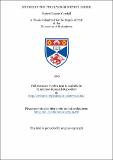Files in this item
Studies in the pyrolysis of methyl iodide with particular reference to the transition from first to second order kinetic behaviour
Item metadata
| dc.contributor.advisor | Horrex, Charles | |
| dc.contributor.author | Cundall, Robert Bowser | |
| dc.coverage.spatial | 144 p. | en_US |
| dc.date.accessioned | 2018-07-17T10:58:31Z | |
| dc.date.available | 2018-07-17T10:58:31Z | |
| dc.date.issued | 1953 | |
| dc.identifier.uri | https://hdl.handle.net/10023/15478 | |
| dc.description.abstract | (1) The previous work of Lapage on the decomposition of methyl iodide has been extended and confirmed in all essential detail. In particular attention has been paid to the transition from first order to second order kineties as the total pressure of the reacting system is lowered and the activating efficiencies of different inert gases have been evaluated. (2) It is concluded that the reaction mechanism shows the following features:- (a) the primary step under all conditions is the dissociation into methyl radicals and iodine atoms. High Pressure Experiments. (b) It has been shown that increasing additions of toluene can result in the complete capture of the methyl radicals provided that its pressure is about 8 mm. and the inert gas pressure is about 600 mm. thereby impeding diffusion to the walls where destruction can otherwise occur by 4CH₃ 3CH₄ + C. (The toluene pressures used by Lapage tended to be rather low for the purpose). (c) The reaction conducted in the above conditions with added toluene is faster than in its absence. This shows no chain reaction is involved but a recombination process of methyl radicals and iodine is occurring. (d) The recombination reaction has been proved by the effect of increasing additions of iodine to the system, causing a decrease in rate. This point was not proved in previous work. (e) During the investigations with added toluene it has been noted and proved by separate experiments that iodine and toluene react with the production of hydrogen iodide. It is suggested that this is due to C₆H₅CH₃ + I. Experiments on this aspect of the work involved mass spectrometric analysis of products. (f) In the presence of sufficient toluene and with about 600 mm. of nitrogen the first order constant has a temperature dependence given by log k₁ = 13.7 - 54,700/2.303RT in agreement with Lapege. (g) A study has been made of the effect of nitrogen pressure on the rate of reaction in the range 100 - 600 mm. nitrogen. No effect was observed. Taken in conjunction with the conclusions detailed below, it is considered that this shows that the high pressure limiting rate of decomposition was stained in this region. Low Pressure Experiments. (a) The products of the reaction were shown to be carbon, methane and iodine, in agreement with the equation 4CH₃I 3CH₄ + C2I₂. Analyses were made by the mass spectrometer for ethane and it was shown to account for only 1% approximately of the products. (b) Reproducibility of the experiments was enhanced by using a carbon coated vessel. (c) At the low pressures used (4 mm. nitrogen and 0.1 mm. methyl iodide) with decompositions usually no greater than 3 % iodine did not spear to inhibit the reaction. This was proved by direct additions. (d) Extensive verification has been made of the fact that a decline in rate of reaction occurs as the pressures of nitrogen and methyl iodide are lowered below 10 mm. and 0.5 mm. respectively. This has been shown to occur over a wide range of temperatures and the first order behaviour changes to second order at lower pressures. (e) The effect of the following gases has been investigated in order to confirm the theory of second order to first order transition for this reaction. All the data are in agreement with this view. (f) Using a treatment analogous that given by johnston102 the following efficiencies as activators have been deduced. CH₃I 1, N₂ 0.13, CH₄ 0.083, CO 0.038, NO 0.80, He 0.043, Ne 0.049, A 0.053, Kr 0.041. (g) The bimolecular constant for the reaction has been found at various temperatures and shown to be described by log k₂ = 14.5 - E/RT. 2.303 (1.mol.⁻¹ sec.⁻¹). E = 54.4 k.cal./mole. This value of E is in agreement with that derived from the high pressure first order constants. (h) A discussion of the efficiencies of the inert gases has been given. | en_US |
| dc.language.iso | en | en_US |
| dc.publisher | University of St Andrews | |
| dc.subject.lcc | QD517.C8 | |
| dc.subject.lcsh | Chemistry, physical and theoretical | en |
| dc.title | Studies in the pyrolysis of methyl iodide with particular reference to the transition from first to second order kinetic behaviour | en_US |
| dc.type | Thesis | en_US |
| dc.contributor.sponsor | University of St Andrews | en_US |
| dc.type.qualificationlevel | Doctoral | en_US |
| dc.type.qualificationname | PhD Doctor of Philosophy | en_US |
| dc.publisher.institution | The University of St Andrews | en_US |
This item appears in the following Collection(s)
Items in the St Andrews Research Repository are protected by copyright, with all rights reserved, unless otherwise indicated.

